A Royal Air Force Typhoon conducted a routine air interception training exercise this afternoon involving a French military aircraft transiting UK airspace.
The intercept occurred over Bournemouth, with a subsequent escort phase over the English Channel.
The aircraft involved was a French Air and Space Force TBM 700 (serial 117), operating under the callsign CTM3822. The light turboprop departed France and entered UK-controlled airspace at an altitude of approximately 19,450 feet.
RAF Typhoon ZJ929, using the callsign RIGID012, intercepted the TBM near Bournemouth and continued to shadow it as it transited southward. The Typhoon was squawking 1327, part of the NATO transponder code range (1301–1327) designated for Air Policing and Air Defence Priority Flights.
While the transponder code range is also used for live QRA responses, this sortie was a planned training intercept. The flight profiles, consistent headings, and lack of irregular manoeuvring all support this assessment. In this case, it is confirmed that the activity formed part of a routine training scenario rather than a real-world scramble.
Training intercepts like this are a standard component of RAF and NATO air defence practice. Light military aircraft such as the TBM 700 are regularly used to simulate unidentified or non-cooperative radar tracks, allowing RAF Typhoon crews to practice interception, visual identification, and escort procedures under operational conditions.
The UK maintains round-the-clock QRA coverage from RAF Coningsby and RAF Lossiemouth. Regular training exercises such as this one ensure that aircrews remain prepared for genuine air policing events, supporting both national defence and NATO-integrated airspace security frameworks.
The Typhoon FGR4
The Eurofighter Typhoon FGR4 is a multirole combat aircraft operated by the Royal Air Force, designed to deliver high performance in both air-to-air and air-to-surface missions. It features a single-seat configuration, digital fly-by-wire controls, and advanced cockpit systems to support pilot situational awareness. Powered by two Eurojet EJ200 turbofan engines generating approximately 20,000 pounds of thrust each, the aircraft can achieve speeds exceeding Mach 2 and operate at altitudes above 55,000 feet, with a high thrust-to-weight ratio contributing to superior agility.
The Typhoon FGR4 is equipped with the Captor-M mechanically scanned radar, providing multi-target tracking and engagement capability. The aircraft is scheduled to receive the Captor-E active electronically scanned array radar, which will enhance detection range, tracking reliability, and resistance to electronic countermeasures. Defensive systems are managed by the Praetorian Defensive Aids Sub-System, which includes radar warning receivers, missile approach warning systems, electronic countermeasures, and chaff and flare dispensers, offering a comprehensive electronic warfare suite.
Armament options on the Typhoon FGR4 include a wide range of air-to-air and air-to-surface munitions. It carries the AIM-120 AMRAAM and AIM-132 ASRAAM for short- and medium-range air combat, and is integrated with the MBDA Meteor missile, which provides extended-range beyond visual range engagement capability through a ramjet propulsion system and active radar seeker. For strike missions, it can employ Paveway IV laser/GPS-guided bombs, Brimstone missiles for precision ground attack, and Storm Shadow cruise missiles for deep-strike missions. The aircraft is also fitted with a 27 mm Mauser BK-27 cannon.
The Typhoon FGR4 supports rapid mission switching, allowing it to conduct air combat, ground attack, and reconnaissance operations within the same sortie. Its reconnaissance capabilities are supported by targeting pods such as the Litening III, offering high-resolution imaging and laser designation. The aircraft incorporates secure datalinks, including Link 16, for networked operations with allied forces. Its operational record includes deployments in the Middle East and North Africa, where it has demonstrated multirole functionality in both high-intensity and counterinsurgency environments.



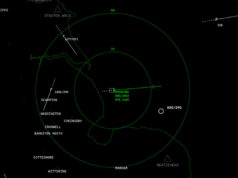
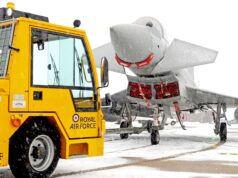
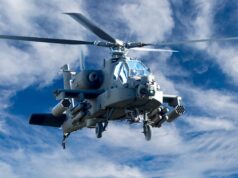
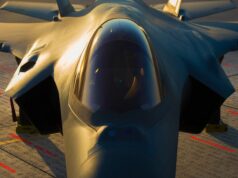
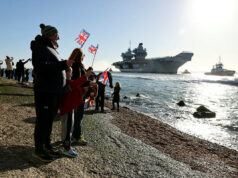
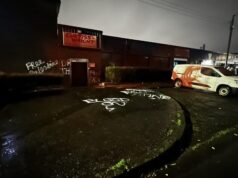
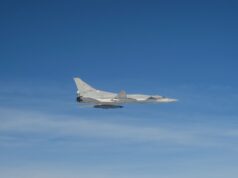
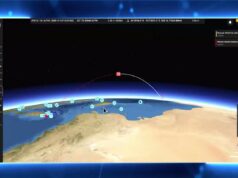
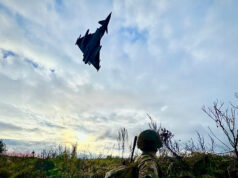

At least another 80 Typhoons are needed.plus a minimum of 50 F35 A,s
“Rat a tat tat tat tat tat , take that you pesky frenchy.
2nd 100 years war anyone? Weirder things have happened in the past couple of years.
So we are at Coningsby and saw the take off and landing of this QRA practice. This aircraft is a tranche 1 but carrying a Meteor missile. First time I have been aware of a Tranche1 carrying a Meteor, there must have been an upgrade or perhaps a dummy? I have photographic evidence!
I see these and loads of American stuff daily, still an impressive sight, the wife wants us to move but I love being in the “Magic Triangle” you never know what will land next.
“Life is like a box of chocolates”.
The Battle of Britain flight and the Red Arrows regularly practice over my house.
Your house must have a huge roof !
“Everything is alright, up on the roof”
Drifters.
If was Tranch 1 it proves it is exactly why we should keep for QRA, 25 airframes should be about right to keep 2-4 QRA aircraft 24/7. use up the airframe hours of those.
Show your picture – the Tranch 1’s cannot use Meteor .
PR attempt to show that the RAF has its eye on the ball after the paint spraying episode.
Huzzah! Strike now! Princess Anne as Queen of France.
The most boring defence story ever, well done. 👍🏿
They reckon their sausage rolls are the best, I reckon it’s a “Gregs Mith”.
This is a Half Baked story from a Half Wit.
Can we not intercept the boats from France 😴